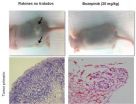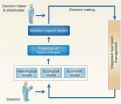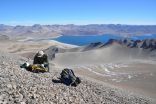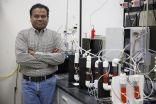INFORMATION:
The article can be downloaded from the following link:
http://www.impactjournals.com/oncotarget/index.php?journal=oncotarget&page=article&op=view&path[]=1962
Research team proves the efficacy of new drug against stem cells that provoke the growth of cancer
The new drug, called Bozepinib, has been successfully tested in mice
2014-11-26
(Press-News.org) An Andalusian team of researchers led by the University of Granada has demonstrated the efficacy of a new drug against cancerogenic stem cells, which cause the onset and development of cancer, of relapse after chemotherapy and metastasis. This drug, called Bozepinib, has proved to be effective in tests with mice. The results have been published in the prestigious journal Oncotarget.
Cancerogenic stem cells appear in small quantities in tumours, and one of their important features is that they contribute to the formation of metastasis in different places within the original tumour. Cancerogenic stem cells remain dormant under normal conditions (i.e. they do not divide). Conventional chemotherapy and radiotherapy act upon those cancer cells which are clearly differentiated--i.e. which are undergoing processes of division--but they cannot destroy these dormant cancerogenic stem cells. Actually, after a positive initial response to treatment, many cancer patients suffer a relapse because these cancerogenic stem cells have not been destroyed.
During the last few years, research in fight against cancer has focused on the search for new drugs that can selectively attack these cancerogenic stem cells. If they can be eliminated, the tumour will then be eliminated in its entirety, which will lead to the complete curation of patients.
Scientists in the "Advanced therapies: differentiation, regeneration and cancer" research group led by UGR professor Juan Antonio Marchal have collaborated with Joaquín Campos, from the School of Pharmacy, U. of Granada, and María Ángeles García, from Virgen de las Nieves University Hospital in Granada, as well as with the universities of Jaen and Miami (US) to develop the new drug Bozepinib.
Clinical tests on patients
This new drug shows a selective type of activity against cancerogenic stem cells in breast, colon, and skin cancers. "The powerful anti-tumour activity of Bozepinib is due to the inhibition of the HER2 signalling pathway, and to the fact that this drug inhibits the invasiveness and the formation of new vessels in the tumour (angiogenesis)", says prof. Juan Antonio Marchal. Researchers have also revealed the specific mechanism by means of which Bozepinib acts against cancerogenic stem cells
This new drug proved to be nontoxic for healthy mice when it was intraperitoneally or orally administered, and it also inhibited tumoural growth and the formation of lung metastasis in those mice in which the tumour was induced.
Researchers are currently conducting safety tests and they expect that this new drug, as well as its derivatives, can be run through clinical tests with actual patients in the near future.
ELSE PRESS RELEASES FROM THIS DATE:
Diverting a river from ecological disaster in northwestern China could provide new sustainable model
2014-11-26
For tens of thousands of years, modern humans have used the waterways to spread out across the surface of the planet. Major civilizations developed along massive rivers like the Nile in Egypt and the Yellow River in China, and massive water channels propelled the expansion of economies around the world. But in recent decades, according to a team of scientists at the Cold and Arid Regions Environmental and Engineering Research Institute, Chinese Academy of Sciences, in the northwestern Chinese city of Lanzhou, the competition between economic growth and the ecosystem of ...
Young scientist discovers new method to achieve ultra-narrow laser linewidth
2014-11-26
Chongqing, China--Dr. Tao Zhu and his team of researchers from Chongqing University, Southwest China, have discovered a new method to highly compress laser linewidth based on Rayleigh backscattering. Using their new method, Rayleigh backscattering can be collected in any waveguide structure and all wave bands to effectively compress a laser linewidth to merely hundreds of hertz, which could have a revolutionary impact on the field of laser technology. This makes it possible for portable laser devices to achieve an ultra-narrow linewidth at room temperature, which until ...
Hacked emails slice spam fast
2014-11-26
Spam spreads much faster and to more people when it is being propagated by hacked, or otherwise compromised, email accounts rather than legitimate accounts, according to research published in the International Journal of Security and Networks. The insight should help those modeling the dynamics of information diffusion as well as those hoping to track and trace spam with a view to slowing or blocking its propagation. Spam traditionally contained ads for fake or counterfeit products, but currently also contains disruptive rumors and information of a political nature.
Ghita ...
Glassy protein solution may cause eyesight deterioration
2014-11-26
Long-sightedness caused by age could be due to proteins in the lens of the eye that are converted from a fluid solution to a solid, glassy state. This has been shown in a study by researchers from institutions including Lund University.
Around the age of 40-50, many people find their sight deteriorates and they need to use reading glasses. This age-related long-sightedness is thought to be due to a reduction in the elasticity of the lens in the eye. A new research study appears to have put its finger on the details of what happens in the eye when long-sightedness develops.
"This ...
New guide to the genetic jungle of muscles can help health research
2014-11-26
How do the genes in the cells inside the body's muscles respond when the muscles are put to work? And how are these genes affected when muscles are not used? What importance do activity and, on the other hand, lack of activity have for the organism's metabolism, and thus also for diseases such as diabetes and obesity?
These questions form the basis for a new study from the Department of Public Health at Aarhus University and the Institute of Sports Medicine at Bispebjerg Hospital. For the first time, the study compares the reactions of all genes in the muscles to diverse ...
New international collaboration investigates the Laguna del Maule Volcanic Field, Chile
2014-11-26
Boulder, Colorado, USA - The Laguna del Maule Volcanic Field, Chile, includes a record of unusually large and recent concentration of silicic eruptions. Since 2007, the crust there has been inflating at an astonishing rate of 25 centimeters per year. This unique opportunity to investigate the dynamics of a large rhyolitic system while magma migration, reservoir growth, and crustal deformation are actively under way is stimulating a new international collaboration.
Explosive eruptions of large-volume rhyolitic magma systems are common in the geologic record and pose a ...
Process converts human waste into rocket fuel
2014-11-26
GAINESVILLE, Fla. --- Buck Rogers surely couldn't have seen this one coming, but at NASA's request, University of Florida researchers have figured out how to turn human waste -- yes, that kind -- into rocket fuel.
Adolescent jokes aside, the process finally makes useful something that until now has been collected to burn up on re-entry. What's more, like so many other things developed for the space program, the process could well turn up on Earth, said Pratap Pullammanappallil, a UF associate professor of agricultural and biological engineering.
"It could be used on ...
New research shows sportswomen still second best to sportsmen...in the press!
2014-11-26
DESPITE a sequence of stellar performances by Britain's female athletes and team game players, coverage of women's sport in the Press still occupies a fraction of the space given to men, according to University of Huddersfield lecturer Deirdre O'Neill, who has analysed thousands of articles in newspapers that she describes as a "football-saturated boyzone".
One side effect of this marginalisation of women's sport is that girls - with fewer role models to admire - are much less likely to take part themselves. They leave school half as active as young men, leading to potential ...
Bioengineering study finds two-cell mouse embryos already talking about their future
2014-11-26
Bioengineers at the University of California, San Diego have discovered that mouse embryos are contemplating their cellular fates in the earliest stages after fertilization when the embryo has only two to four cells, a discovery that could upend the scientific consensus about when embryonic cells begin differentiating into cell types. Their research, which used single-cell RNA sequencing to look at every gene in the mouse genome, was published recently in the journal Genome Research. In addition, this group published a paper on analysis of "time-course"single-cell data ...
New evidence of ancient rock art across Southeast Asia
2014-11-26
Latest research on the oldest surviving rock art of Southeast Asia shows that the region's first people, hunter-gatherers who arrived over 50,000 years ago, brought with them a rich art practice.
Published this week in the archaeological journal Antiquity, the research shows that these earliest people skilfully produced paintings of animals in rock shelters from southwest China to Indonesia. Besides these countries, early sites were also recorded in Thailand, Cambodia and Malaysia.
Griffith University Chair in Rock Art Professor Paul Taçon led the research which ...
LAST 30 PRESS RELEASES:
Renuka Iyer, MD, named new Chief Medical Officer for National Comprehensive Cancer Network (NCCN)
New organ-on-a-chip platform allows the testing of cancer vaccine efficacy in aging populations
No, we don't need more and more data about nature. We need more people to use the data
Research explores effect of parental depression symptoms on children’s reward processing
Phonetic or morpholexical issues? New study reveals L2 French ambiguity
Seeing inside smart gels: scientists capture dynamic behavior under stress
Korea University researchers create hydrogel platform for high-throughput extracellular vesicle isolation
Pusan National University researchers identify the brain enzyme that drives nicotine addiction and smoking dependence
Pathway discovered to make the most common breast cancer tumor responsive to immunotherapy
Air pollution linked to more severe heart disease
Where the elements come from
From static papers to living models: turning limb development research into interactive science
Blink and you will miss it: Magnetism switching in antiferromagnets
What’s the best way to expand the US electricity grid?
Global sports industry holds untapped potential for wildlife conservation
USF-led study reveals dramatic decline in some historic sargassum populations
Fullerenes for finer detailed MRI scans
C-Compass: AI-based software maps proteins and lipids within cells
Turning team spirit into wildlife action
How influenza viruses enter our cells
New camera traps snap nearly three times more images of endangered Sumatran tigers than before
Survey: Nearly all Americans not aware midwives provide care beyond pregnancy, birth
Fearless frogs feast on deadly hornets
Fibulin-5: A potential marker for liver fibrosis detection
Development of 'OCTOID,' a soft robot that changes color and moves like an octopus
Marriage, emotional support may protect against obesity through brain-gut connection, study finds
High-speed all-optical neural networks empowered spatiotemporal mode multiplexing
High-energy-density barocaloric material could enable smaller, lighter solid-state cooling devices
Progresses on damped wave equations: Multi-wave Stability from partially degenerate flux
First discoveries from new Subaru Telescope program
[Press-News.org] Research team proves the efficacy of new drug against stem cells that provoke the growth of cancerThe new drug, called Bozepinib, has been successfully tested in mice





